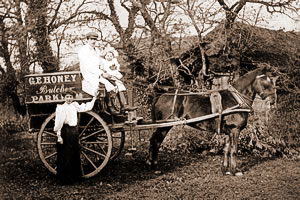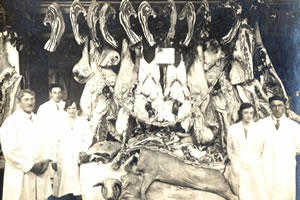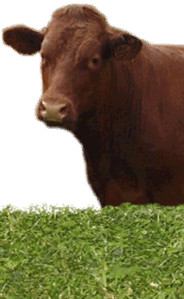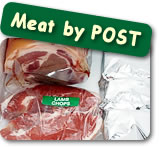A brief history
In 1902, at the age of 21, George Edward Honey began a butchers business in Parkham from Manor Cottage which he rented with his new wife Rhoda. There were 3 other butchers operating in Parkham at the time but due to his high standards and cleanliness he became successful enough to be able to buy a property in 1910, Oliver House, which came with 7 acres and some farm buildings. It was here that he built a slaughterhouse which was used through to the 1960’s. Like most other butchers at that time he made deliveries with horse and trap and attended the butchers row at Bideford Pannier Market twice a week.

Horse and Cart Delivery 1907
George Edward Honey, his wife Rhoda and baby ‘Mort’
George and Rhoda had 2 children, George Mortimer and Gwen. Mort, as he was known, worked in the business and married Ethel in 1932. At this time the house was extended to accommodate extra family and to provide a shop at the front of the property. Mort and Ethel ran the business through the 2nd world war and rationing. They were granted a licence to make sausages, using ingredients supplied by the war ministry, which were not subject to rationing but had to be sold from a separate shop in the market. Long queues would form as people came to buy as many sausages as they could get. This created a lot of extra work and their children, George, Donald and Sylvia had to help bone out the meat from as young as 8 years old.

Christmas Market display around 1930. L-R: George Edward Honey, Mort, Rhoda, Gwen and Jack Nicholls
On returning from National Service Donald came into the business, taking over in 1962 with his wife Jean. After enlarging the shop and building more fridge and freezer space, in 1972 Donald built a pig rearing facility on the farm which provided the shop with all our pig requirements for the next 30 years. More land was bought in 1976 bringing the farm to its present size. Donald and Jean had 3 children; Andrew, Angela and Roger, both sons worked in the business on leaving school.
Andrew, his wife Rosalind, their daughter Louise and four members of staff (Carmen, Geoff, Paul and Roger) continue to operate the original business from Parkham. At the rear of Oliver House is a building which has always been known as the Dixie House, this is where the shop was located between 1910 and 1932, but is now where we undertake our manufacturing and cooking operations.


